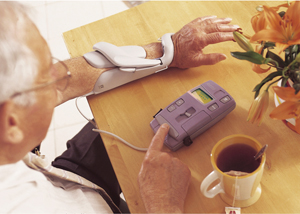
Stallworth Rehabilitation Hospital is using new technology to help stroke victims regain hand function.
Device gives stroke patients a ‘hand’
Vanderbilt Stallworth Rehabilitation Hospital is offering patients a new, advanced technology to help stroke patients and others suffering neurologic injuries affecting hand function.
The new neuroprosthesis device helps patients regain hand function to grasp and release objects, tasks some stroke victims believe to be impossible to regain.
Vanderbilt Stallworth is the first in Middle Tennessee to offer the NESS H200 device and will serve as a regional assessment site for therapists and patients interested in evaluating the new technology.
The NESS H200 consists of a simple splint that slips over the patient's forearm and hand. Embedded in the device are five surface electrodes that stimulate muscles responsible for grasping and releasing objects. A microprocessor allows the therapist to program the device with a series of exercises customized for each patient.
Howard Kirshner, M.D., vice chair of the Department of Neurology and Stallworth's Stroke Program medical director, says the device offers tremendous benefits over traditional therapy for patients with stroke, spinal cord and brain injury, helping them to restore lost hand function.
“We are very excited about incorporating this technology into both the acute rehab programs and outpatient services,” Kirshner says. “There are substantial clinical studies pointing to the value of functional electrical stimulation for neuromuscular re-education early in a patient's recovery.”
The new device is just one of several cutting-edge technologies Stallworth offers stroke survivors. These modalities, along with traditional therapy, have helped Stallworth gain recognition within the HealthSouth system of inpatient hospitals as a Stroke Center of Excellence.
“This designation supports the experience and expertise of our physician, nursing and therapy staff in identifying and treating the disabilities related to stroke, including both the more obvious physical disabilities and the more subtle cognitive impairments,” said Kirshner.













